Studies of ROV concepts 2018 - 2019









Date of publication: 2019
Authors: Muhammad Ikhsan Sani, Simon Siregar,
Muhammad Muchlis Kurnia, Dzikri Hasbialloh.
Abstract:
Remotely Operated Vehicle ROV) for underwater
exploration is typically controlled using an umbilical cable
connected to a ground control station. Unfortunately,
while it is used for power distribution and data
transmission, it also obstructs the movement of ROV,
especially for shallow water (<50 cm).
This paper proposed an alternative method for controlling
ROV using a wireless remote control system. This work
also aims to explore the possibility of using RF wireless
technology between 420-450 MHz as an underwater
communication system.



Date of publication: 2019
Authors: Muhammad Ikhsan Sani, Simon Siregar,
Muhammad Muchlis Kurnia, Dzikri Hasbialloh.
Abstract:
The importance of an optimal method for electric
power transmission is crucial for ROV operation.
Meanwhile, only a few studies have shown the effect
of the electrical power system from power supply to
ROV. This paper proposes a design and
implementation of an electrical power system for ROV
developed by the Tech_SAS team from Telkom
University, Bandung, Indonesia.


Date of publication: 2019
Authors:
Dhimas Satria, Romi Wiryadinata, Dpal Esiswitoyo,
Muhamad Haykal, Fasya, Imron Rosyadi, Sidik Susilo,
& Rina Lusiani.
Abstract:
The suitable technology to find out information on the
bottom of the Sunda Strait in Indonesia is ROV. However,
the existing ROVs have limitations linked to their structure
and hydrodynamic. For these reasons, researches on
design concepts have been conducted to obtain the best
front surface geometry modeling of the ROV body.

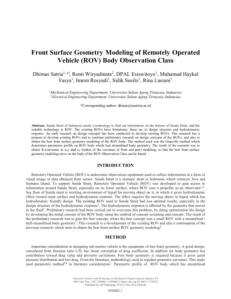


Date of publication: 2019
Authors:
Muhammad Syukron, Nuralif Mardiyah, Wahono, Ahmad
Rosikhin, & Zamah Sari
Abstract:
This paper describes an ROV (Remotely Operated Vehicle)
that can take samples of contaminated water and soil
while the pilot operates it from the shore or a ship.

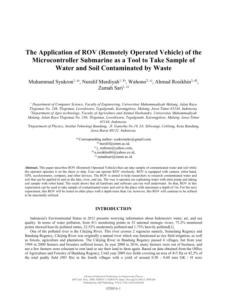


Date of publication: 2018
Authors:
Thomas Thuesen Enevoldsen, Emil M´ar Einarsson, Simon
Pedersen, Zhenyu Yang.
Abstract:
The expansion of subsea applications demands extended
use of autonomous capabilities within Remotely Operated
Vehicles (ROVs), which can reduce the overall operation
time and cost. Obtaining a simple but also reasonably
precise model is important for an autonomized control
strategy. This study outlines a low-dimensional model
structure for a commercial underwater inspection ROV,
based on simplifying physical assumptions.

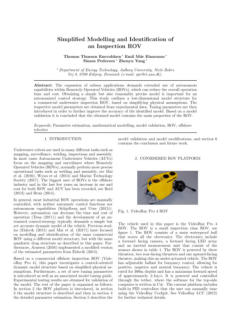

Date of publication: 2018
Authors:
Satja Sivˇcev, Matija Rossi, Joseph Coleman, Edin Omerdi´,
Gerard Dooly,& Daniel Toal
Abstract:
Work-class ROVs equipped with robotic manipulators are
extensively used for subsea intervention operations.
Manipulators are teleoperated by human pilots relying on
visual feedback from the worksite. Operating in a remote
environment, with limited pilot perception and poor
visibility, manipulator collisions which may cause significant
damage are likely to happen. This paper presents a real
time collision detection algorithm for marine robotic
manipulation.



Authors:
Charles Ramey, Matthew Meister, Anthony Spears. Josh
Lutz, Daniel Dichek, Ben Hurwitz, Justin Lawrence,
Jade Lawrence, Margaret Philleo, & Britney E.
Schmidt
Abstract:
Icefin is a hybrid ROV/AUV, designed to function as a
robotic oceanographer in the Antarctic under-ice waters.
Autonomous command, control, and navigation of such
robotic platforms in remote sub-ice environments is
extremely challenging, but also niche enough of an
application to not benefit from the foundation of a wide
community of open-source research.

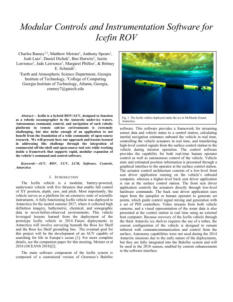

Date of publication: 2019
Authors: A Yu Konoplin, N Yu Konoplin, V F Filaretov
This article describes the system of intellectual support for
remotely operated vehicle (ROV) operators, which
provides the precise movements control of the ROV and
its depressor-weight along the specified trajectories, even
in the case when the supporting vessel has no a dynamic
positioning system. Proposed system provides operators
with visual recommendations and warnings, which are
formed in real time on the basis of expert evaluation of the
information obtained from various sensors and navigation
systems.

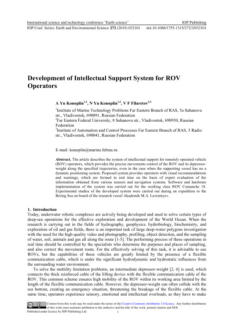

Date of publication: 2019
Authors:
Eleni Kelasidi, Signe Moe, Kristin Y. Pettersen, Anna m.
Kohl, Pål Liljebäck, & Jan Tommy Gravdahl.
Abstract:
Attractive unmanned underwater vehicles are bio-
inspired robots such as underwater snake robots
(USRs). Due to their flexible and slender body, these
versatile robots are highly maneuverable and have
better access capabilities than more conventional
remotely operated vehicles (ROVs). Moreover, the long
and slender body allows for energy-efficient transit
over long distances, similar to torpedo-shaped
autonomous underwater vehicles (AUVs). In addition,
USRs can perform light intervention tasks, thereby
providing intervention capabilities that exceed those of
AUVs and inspection class ROVs. USRs may also propel
themselves using energy-efficient motion patterns
inspired by their biological counterparts. They can
thereby increase the propulsion efficiency during
transit and maneuvering, which is among the
significant challenges for autonomous underwater
vehicles.



Date of publication: 2019
Authors: Ved Chirayath, Alan Li
The authors highlight three emerging NASA optical
technologies that enhance the ability to remotely sense,
analyze, and explore ocean worlds–FluidCam and fluid
lensing, MiDAR, and NeMO-Net. Fluid lensing is the first
remote sensing technology capable of imaging through
ocean waves without distortions in 3D at sub-cm
resolutions.
Fluid lensing and the purpose-built FluidCam CubeSat
instruments have been used to provide refraction-
corrected 3D multispectral imagery of shallow marine
systems from unmanned aerial vehicles (UAVs).

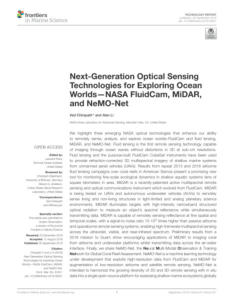

Date of publication: 2019
Authors:
Charalampos P. Bechlioulis, Fotis Giagkas, Georges C.
Karras, Kostas j. Kyriakopoulos.
Abstract:
This paper addresses the distance-based formation control
problem for multiple Autonomous Underwater Vehicles
(AUVs) in a leader-follower architecture. The leading AUV
is assigned a task to track the desired trajectory, and the
following AUVs try to set up a predefined formation
structure by attaining specific distances among their
neighboring AUVs, while avoiding collisions and enabling
at the same time relative localization.



Date of publication: 2019
Authors:
Oscar Adrian Aguirre-Castro, Everardo Inzunza-
González, Enrique Efrén García-Guerrero,
Esteban Tlelo-Cuautle, Oscar Roberto López-
Bonilla, Jesús Everardo Olguín-Tiznado, and
José Ricardo Cárdenas-Valdez
Abstract:
The design of a remotely operated vehicle (ROV) with
a size of 18.41 cm × 29.50 cm × 33.50 cm and a
weight of 15.64 kg is introduced herein. The main
goal is to capture underwater video by remote control
communication in real-time via Ethernet protocol.

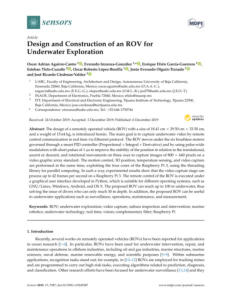

Date of publication: 2019
Published by Arobot
AROBOT is a design consultancy & Solutions provider
for Industry Automation, training, research &
development company based in Chennai, India



Authors:
Petar Trslic, Matija Rossi, Luke Robinson, Cathal W.
O’Donnel, Anthony Weir, Joseph Coleman, James
Riordan, Edin Omerdic, Gerard Dooly, & Daniel Toal.
This paper presents autonomous docking of an industry-
standard work-class ROV to static and dynamic docking
stations using visual-based pose estimation techniques.
This is the first time autonomous docking to a dynamic
docking station has been presented. Furthermore, the
system does not require a specially designed docking
station but uses a conventional cage-type TMS.

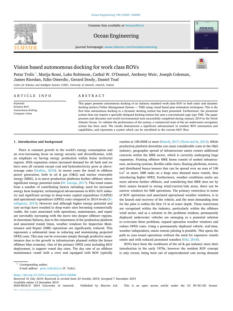

Date of publication: 2018
Authors:
Simon Pedersen, Thomas Thuesen Enevoldsen, & Emil
M´ar Einarsson.
This study outlines a grey-box control-oriented model
comparison of a VideoRay Pro 4 Underwater Inspection
ROV with autonomous features. The respective models
are developed and identified in previous studies and are
based on three different model principles. The models are
evaluated based on open-loop experimental tests with
and without multiple thruster actuation. The tests show
significant dynamic coupling between several motions,
which none of the models estimate with sufficient
accuracy without model extensions.



Authors: Hongde Qin, Zheyuan Wu, Yanchao Sun,
and Yushan Sun.
The ocean bottom flying node is a novel autonomous
underwater vehicle that explores deep water's oil and
gas resources. Based on a predefined performance
function and an error transformation, the ocean
bottom flying node trajectory tracking error is restricted
to prespecified bounds to ensure a desired transient
and steady response.

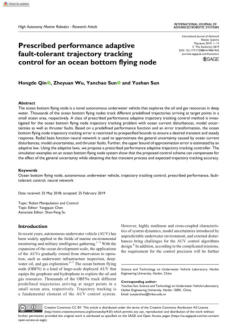

Authors:
Arturo Gomez Chavez, Christian A Mueller, Tobias
Doernbach and Andreas Birk.
Intervention missions in the context of oil-&-gas
production require precise and robust navigation. In this
article, the authors describe the use of an advanced vision
system suited for deep-sea operations, which in
combination with artificial markers on target structures like
oil-&-gas production-Christmas-trees, significantly boosts
navigation performance.

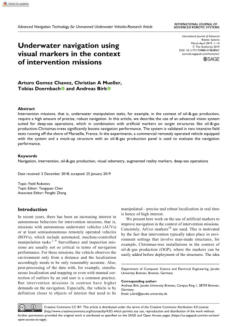

Authors: Dianne L. McLean, Miles J. G. Parsons,
Andrew R. Gates, Mark C. Benfield, Todd
Bond, David J. Booth, Michael Bunce, Ashley
M. Fowler , Euan S. Harvey, Peter I. Macreadie
, Charitha B. Pattiaratchi, Sally Rouse, Julian C.
Partridge, Paul G. Thomson, Victoria L. G.
Todd, and Daniel O. B. Jones.
Through slight modifications of ROV operations, and by
augmenting industry workclass ROVs with a range of
scientific equipment, industry can fuel scientific discoveries,
contribute to an understanding of the impact of artificial
structures in our oceans, and collect biotic and abiotic
data.

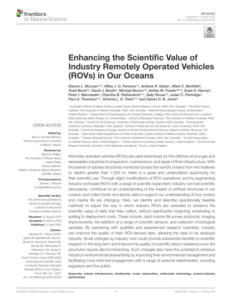

Authors:
Caleb Christianson, Christopher Bayag, Guorui Li, Saurabh
Jadhav, Ayush Giri, Chibuike Agba, Tiefeng Li, and Michael
T. Tolley.
Robots for underwater exploration are typically comprised
of rigid materials and driven by propellers or jet thrusters,
which consume a significant amount of power.
Bioinspired soft robots provide an approach for
underwater exploration in which the robots are
comprised of compliant materials that can better adapt to
uncertain environments and take advantage of design
elements that have been optimized in nature.

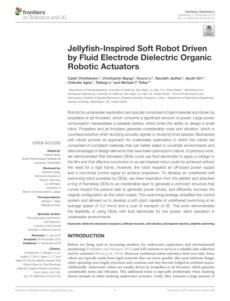

Authors:
Darryn Sward, Jacquomo Monk, and Neville Barrett
Anthropogenic activities and greater demands for marine
natural resources have increased the spatial extent and
duration of pressures on marine ecosystems. Remotely
operated vehicles (ROVs) offer a robust survey tool for
quantifying these pressures and tracking the success of
management intervention while at a range of depths. This
review aims to evaluate ROVs as a survey technique and
to suggest optimal sampling strategies for use in typical
ROV-based studies.



Date of publication: 2018
Authors: Robert K. Katzschmann, Joseph DelPreto,
Robert MacCurdy, Daniela Rus
Closeup exploration of underwater life requires new forms
of interaction, using biomimetic creatures that are capable
of agile swimming maneuvers, equipped with cameras,
and supported by remote human operation. Current
robotic prototypes do not provide adequate platforms for
studying marine life in its natural habitats. This work
presents the design, fabrication, control, and oceanic
testing of a soft robotic fish that can swim in three
dimensions to continuously record the aquatic life it is
following or engaging.

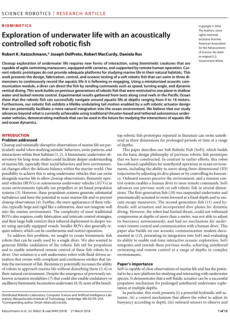

Authors: Satja Sivcev, Matija Rossi, Joseph Coleman,
Gerard Dooly, Edin Omerdie, Daniel Toal
ROVs with hydraulic manipulators are extensively used for
subsea intervention. With camera feedback from the
scene, manipulators are teleoperated and slaved to the
pilot-held master arms. While standard for offshore oil and
gas, for challenging applications in waves or currents a
new approach is required. The authors present the
development of robot arm visual servo control
approaches used in manufacturing, as the transfer and
adaptation of these approaches to
underwater hydraulic manipulators.

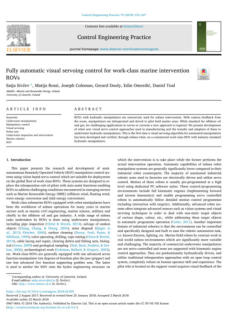

Authors: Taavi Salumäe, Ahmed Chemori, Maarja
Kruusmaa
U-CAT is a highly maneuverable biomimetic 4-fin
underwater robot for operating in confined spaces.
Because of its novel mechanical design and specialized
purpose, traditional autonomous underwater robot
control methods are not directly applicable to U-CAT. This
paper proposes a novel modular control architecture that
can be adopted for various application scenarios.



Authors: Ali Dogrul, Yavuz Hakan Ozdemir, Savas
Sezen, Baris Barlas
In this study, the hydrodynamic performance of the
Duisburg Test Case (DTC), a Post-Panamax container
vessel, has been investigated using Computational Fluid
Dynamics (CFD) tools. The total resistance analysis has
been performed using an optimal grid number, which
was determined through verification and validation
processes based on the Grid Convergence Index (GCI).



Authors: E. Kelasidi, A. M. Kohl, K. Y. Pettersen, B. H.
Hoffmann, J. T. Gravdahl
The robotics community has shown an increasing interest
in developing bio-inspired swimming robots, driven by the
need for more economical, efficient, autonomous, highly
flexible, and maneuverable robotic systems for
underwater operations. In this paper, the authors present
a bio-inspired underwater snake robot (USR) equipped
with a passive caudal (tail) fin. In particular, a highly flexible
USR configuration is presented that is capable of
locomotion both on the ground and underwater due to
its robust mechanical and modular design, which allows
additional effectors to be attached to different modules of
the robot depending on the application's requirements.

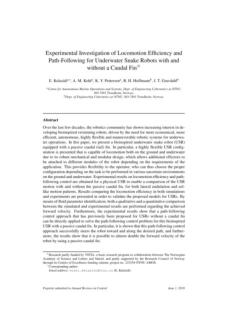

Authors: Eleni Kelasidi, Gard Elgenes, Henrik Kilvaer
The development of underwater snake robots (USRs)
shows promising results toward extending the capabilities
of conventional unmanned underwater vehicles (UUVs).
The slender and multi-articulated body of USRs allows for
operation in tight spaces where other traditional UUVs
are incapable of operating. However, the mathematical
model of USRs is more challenging compared to the
models of ROVs and AUVs because of their multi-
articulated bodies.

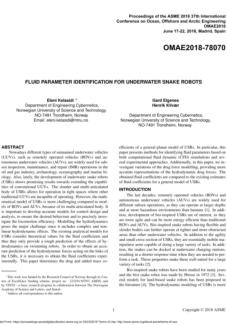

Authors: Roberta Ingrosso, Daniela De Palma,
Giovanni Indiveri, and Giulio Avanzin
A dynamic modeling approach is presented by the
authors to compute the lumped parameter hydrodynamic
coefficients of an underwater vehicle, conceived as a
multi-body underwater system. The vehicle base is
composed of heterogeneous robots and bodies rigidly
connected, giving rise to a multi-body system called
“cluster” in the paper. In order to model the nonlinear
dynamics of the cluster, a modular approach has been
proposed based on a proper composition of the dynamic
models of the individual elements.

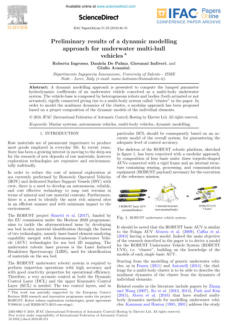

Authors: Satja Sivcev, Joseph Coleman, Edin Omerdic,
Gerard Dooly, Daniel Toal
This paper describes the state-of-the-art in the area of
underwater robot manipulator systems. A brief
introduction is given on the use of manipulators in various
offshore industries for different subsea intervention
applications. It provides a comprehensive summary of
existing commercial and prototype underwater
manipulators, covering relevant aspects such as design
features, capabilities, and merits, and provides a detailed
comparison.



Authors:
Daniel M. Vogt, Kaitlyn P. Becker, Brennan T. Phillips,
Moritz A. Graule, Randi D. Rotjan, Timothy M. Shank, Erik E.
Cordes, Robert J. Wood, David F. Gruber
Soft robotics is an emerging technology that has shown
considerable promise in deep-sea marine biology
applications. It is particularly useful in facilitating delicate
interactions with fragile marine organisms. This study
describes the shipboard design, 3D printing, and
integration of custom soft robotic manipulators for
investigating and interacting with deep-sea organisms.

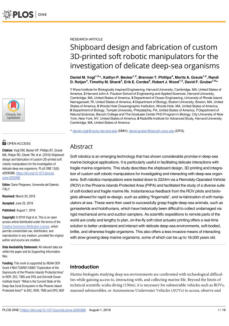

Authors: Jiawang Chen, Yongqiang Ge, Chaoling Yao,
and Binghuan Zheng
The Wave Glider is a new concept marine robot that can
make use of wave energy to obtain thrust. Differing from
the traditional unmanned vehicles, the Wave Glider
consists of a floating body, a connecting tether, and a
submerged glider. It can be regarded as a particular
catamaran structure. Therefore, the conventional kinetic
models of unmanned vehicles are inapplicable to the
Wave Glider. The authors propose a nonlinear kinetic
model of a Wave Glider with six degrees of freedom
based on three reference coordinate frames.

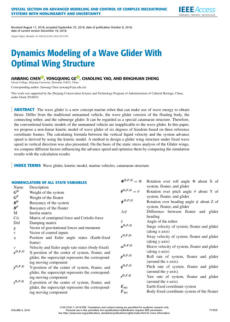

Authors:
Claudio Abels, Antonio Qualtieri, Toni Lober, Alessandro
Mariotti, Lily D. Chambers, Massimo De Vittorio, William M.
Megill and Francesco Rizzi
Flow stimuli in the natural world is varied and contains a
wide variety of directional information. Nature has
developed morphological polarity and bidirectional
arrangements for flow sensing to filter the incoming stimuli.
Inspired by the neuromasts found in the lateral line of fish,
the authors present a novel flow sensor design based on
two curved cantilevers with bending orientation
antiparallel to each other.


Authors:
Zheyuan Gong, Bohan Chen, Jiaqi Liu, Xi Fang, Zemin Liu,
Tianmiao Wang, and Li Wen
Collecting seafood animals cultivated in shallow water is a
profitable and emerging field that requires robotics to
replace human divers.
Soft robotics have several promising features for
performing such a task. In this paper, the authors
implemented a soft manipulator with an opposite
bending and extension structure. A simple and rapid
inverse kinematics method is proposed to control the
spatial location and trajectory of the underwater soft
manipulator’s end effector.


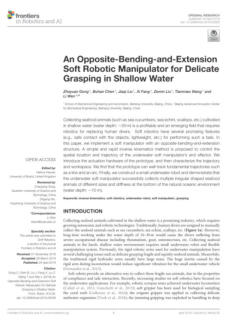

Date of publication: 2019
Authors:
Yue Wang, Victor Kang, Eduard Arzt, Walter Federle, and
Rene Hense
Advances in bio-inspired microfibrillar adhesives have
resulted in technologies that allow reliable attachment to
a variety of surfaces. Although various strategies have
been proposed to achieve strong reversible underwater
adhesion, strong adhesives that work both in air and
underwater without additional surface treatments have
yetto be developed. The authors report a novel cupped
microstructures (CM) that generates strong controllable
adhesion in both air and underwater.

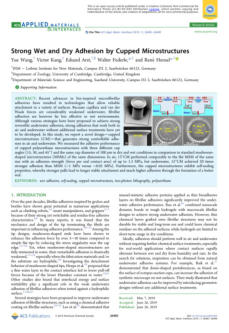

Date of publication: 2019
Authors: Aude Billard, and Danica Kragic
Humans have a fantastic ability to manipulate objects of
various shapes, sizes, and materials and can control the
objects’ position in confined spaces with the advanced
dexterity capabilities of our hands.
Building machines inspired by human hands, with the
functionality to autonomously pick up and manipulate
objects, has always been
an essential component of robotics.

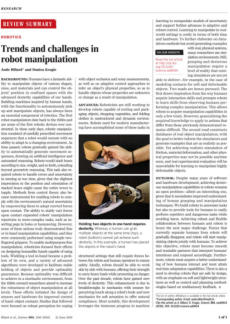

Authors: Petra Ditsche, and Adam Summers
While artificial suction cups only attach well to smooth
surfaces, the Northern clingfish can attach to surfaces
ranging from nanoscale smoothness to rough stone. This
ability is highly desirable for technical applications. The
morphology of the fish’s suction disc and its ability to
attach to rough and slimy surfaces have been described
before. The authors aim to close gaps in the
biomechanical understanding and transfer the
biomechanical principles to technical suction cups. We
demonstrate that the margin of the suction disk is the
critical feature that enables attachment to rough surfaces.

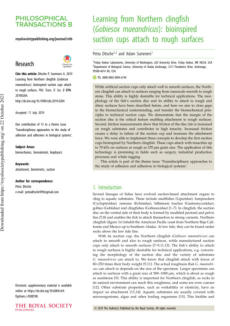

Author: Ali Dogrul
Submerged bodies are commonly used in many fields,
such as scientific research, military operations, and
commercial applications. Especially in military
applications, submarines have a significant role as
silent and deterrent vehicles. Contrary to popular
belief, submerged bodies also operate in shallow
depths where free-surface effects come into play. This
causes the visual identification of submarines while
protecting them from sonar detection. This study
focuses on investigating free-surface effects on
submarine hydrodynamics moving forward at different
depths.



Author:
Nina R. Sinatra, Clark B. Teeple, Daniel M. Vogt, Kevin,
Kit Parker.David F. Gruber, Robert J. Wood
This document presents ultragentle soft robotic
actuators capable of grasping delicate specimens of
gelatinous marine life.
Through an exploration of design parameters and
laboratory testing of individual actuators, the authors
have confirmed that their nanofiber-reinforced soft
actuators apply sufficiently low contact pressure to
ensure minimal harm to typical jellyfish species.



Author:
Hao Pan, Fei Li, Yao Liu, Qinghua Zhang, Meng
Wang, Shun Lan, Yunpeng Zheng, Jing Ma, Lin
Gu, Yang Shen, Pu Yu, Shujun Zhang, Long-
Qing Chen , Yuan-Hua Lin, Ce-Wen Nan
Dielectric capacitors with ultra-high power densities
are fundamental energy storage components in
electrical and electronic systems. However, a long-
standing challenge is to improve their energy densities.
The authors report on dielectrics with ultra-high
energy densities designed using polymorphic
nanodomains.

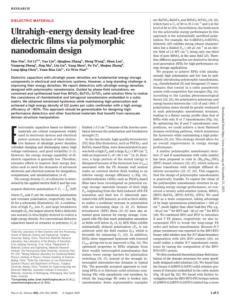

Authors: J. Zhu, C. White , D. K. Wainwright , V. Di
Santo , G. V. Lauder , H. Bart-Smith
Tuna and related scombrid fishes are high-performance
swimmers that often operate at high frequencies,
especially during behaviors such as escaping from
predators or catching prey. This contrasts with most fish-
like robotic systems that typically operate at low
frequencies (< 2 Hz). The authors designed and tested a
new platform based on yellowfin tuna (Thunnus
albacares) and Atlantic mackerel (Scomber scombrus) to
explore the high-frequency fish swimming performance
space.

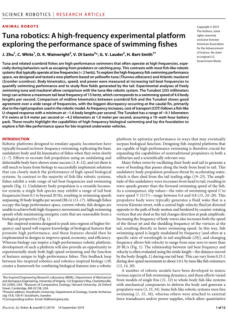

Click on the
octopus to return to
the top of the page

Date of publication: 2018
Authors: Thomas George Thuruthel, Yasmin Ansari, Egidio
Falotico, and Cecilia Lasch
This review paper aims to provide insight into the various
controllers developed for continuum/soft robots as a
guide for future applications in soft robotics. A
comprehensive evaluation of different control strategies
provides insight into future research areas in this field.

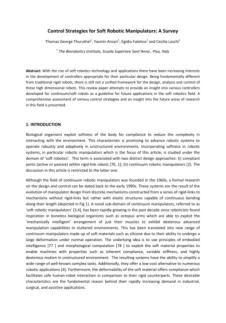

Date of publication: 2018
Authors: Kun Xie, Wei Pan and Suxia Xu
This paper proposes using “the dark channel prior”, a
technique used to remove haze from outdoor images, to
improve image clarity in underwater environments. By
combining this model with the underwater diffusion
model, the approach works well in various scenes.
Experimental results confirm the effectiveness of this
method in underwater environments.

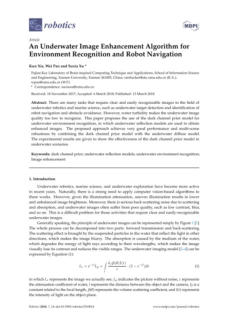

Authors: Simone Marini, Emanuela Fanelli, Valerio
Sbragaglia, Ernesto Azzurro, Joaquin Del Rio
Fernandez, & Jacopo Aguzzi
Marine cabled video observatories are great for observing
sea life, without causing harm. However, they have not
been widely used for monitoring ecosystems due to the
lack of automated video processing methods. This study
presents a new method that uses genetic programming
to analyze images and track the number of fish present.
Additionally, this approach can be applied to other video
observatories.

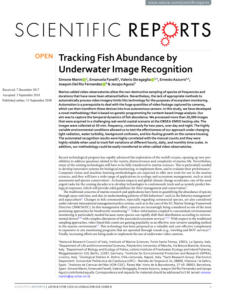

Authors: Chengshi Wang, John Wagner, Chase G.
Frazelle, and Ian D. Walker
Continuum robots are ideal for working in unstructured
environments because of their flexibility and ability to
adapt their shape to perform different tasks. However,
designing controllers for them is challenging due to their
complex dynamics. This paper presents a new control
strategy using a model based on a virtual robot with
discrete joints.This model simplifies the control process,
and simulations show that the method tracks trajectories
accurately.



Authors: Thomas George Thuruthel
This thesis explores machine learning techniques for
controlling soft robots, detailing both simulation and
experimental studies. It examines kinematic and dynamic
controllers developed using learning methods and
validated in open-loop and closed-loop control. It also
investigates the effect of morphology on control strategies
in a simulated octopus model and a soft manipulator.
Additionally, embedded sensing is briefly explored with a
view to developing self-sufficient embodied systems.



Authors:
Thomas George Thuruthel, Egidio Falotico, Federico
Renda, Cecilia Laschi
The dynamic control of soft robotic manipulators remains
largely unexplored. Current applications mainly use static
or quasi-dynamic controllers that do not fully exploit the
system's dynamics. This paper presents a model-based
policy learning algorithm for predictive control that uses a
recurrent neural network and trajectory optimization. The
approach was initially tested on a simulated model and
experimentally validated on a soft pneumatic manipulator,
demonstrating its effectiveness in handling variable
frequencies and external loads.

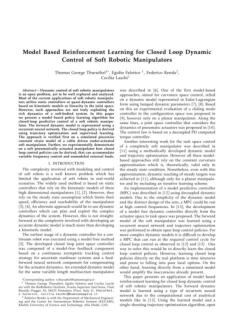

Authors: MD Moniruzzaman, Syed Mohammed Shamsul
Islam, Paul Lavery, and Mohammed Bennamoun
Deep learning has changed the game for spotting objects,
and "Faster Regions with CNN Features” (an object
detection model that uses high-capacity Convolutional
Neural Networks to localize and segment objects) is
leading the pack. The authors have created a dataset of
2,699 underwater photos of Halophila ovalis, which had
not been done until now due to the lack of good datasets
available and the difficulty of distinguishing between
similar-looking plants in underwater photos.

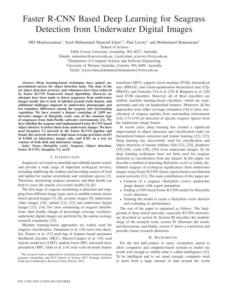

Authors: Naga Sasi Devarakonda
This thesis uses Morison's equation to investigate the
hydrodynamic performance of anguilliform swimming
and validates this method by comparing it with existing
slender body theory and experimental results. It also seeks
to understand the relationship between self-propulsion
speed, oscillating tail amplitude, and forward ratio in the
context of anguilliform swimming.

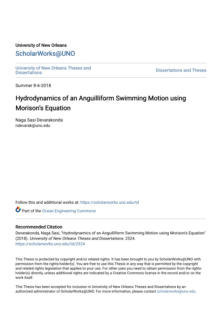

Authors:
Yanwu Zhang, John P. Ryan, Brian Kieft, Brett W. Hobson,
Robert S. McEwen, Michael A. Godin, Julio B. Harvey,
Benedetto Barone, James G. Bellingham, James M. Birch,
This document describes the development and
application of algorithms for autonomous underwater
vehicles (AUVs) that enable them to detect and respond
to specific oceanic phenomena in real time, highlighting
the importance of these methods for studying complex
and evolving ecological phenomena in the ocean, such as
harmful algal blooms and coastal upwelling fronts, by
allowing for more targeted and effective data collection
compared to traditional static grid surveys.





33 - Nonlinear least square approach for range estimation based on
attenuation of EM waves in seawater using world ocean data
from 1955 to 2012

Author: Muhammad Tahir, Piao Yan, Mohsin Raza Jafri
This research paper estimates absorption loss and
spreading loss based on electromagnetic waves
propagation, considering multiple seawater depth points.
The study uses world ocean data from the National
Center for Environmental Information (NCEI) and
computes an antenna polarization factor. The results help
predict the accurate achievable range (R est) using
nonlinear least square (NLLS) approximation and Lambert
transformation. The NLLS approach minimizes mean error
by adapting to actual range. MATLAB is used for
simulation and performance analysis.


Authors: Massimo Mariello, Francesco Guido, Vincenzo
Mariano Mastronardi, Roberto Giannuzzi,
Luciana Algieri, Antonio Qualteri, Alfonso
Massiezzoli, and Massimo De Vittorio
The article discusses the rising demand for waterproofing
solutions and evaluates various polymeric
coatings—namely Parylene-C, PDMS, PMMA, and
PVDF—for their effectiveness in protecting piezoelectric
flexible microdevices. The study finds that while Parylene-C
shows superior anti-corrosive properties, it can micro-crack
during extensive cycles. Additionally, treatments with
oxygen plasma and UV/ozone were applied to enhance
Parylene-C’s surface characteristics, leading to a notable
reduction in biofilm mass following prolonged seawater
exposure.













